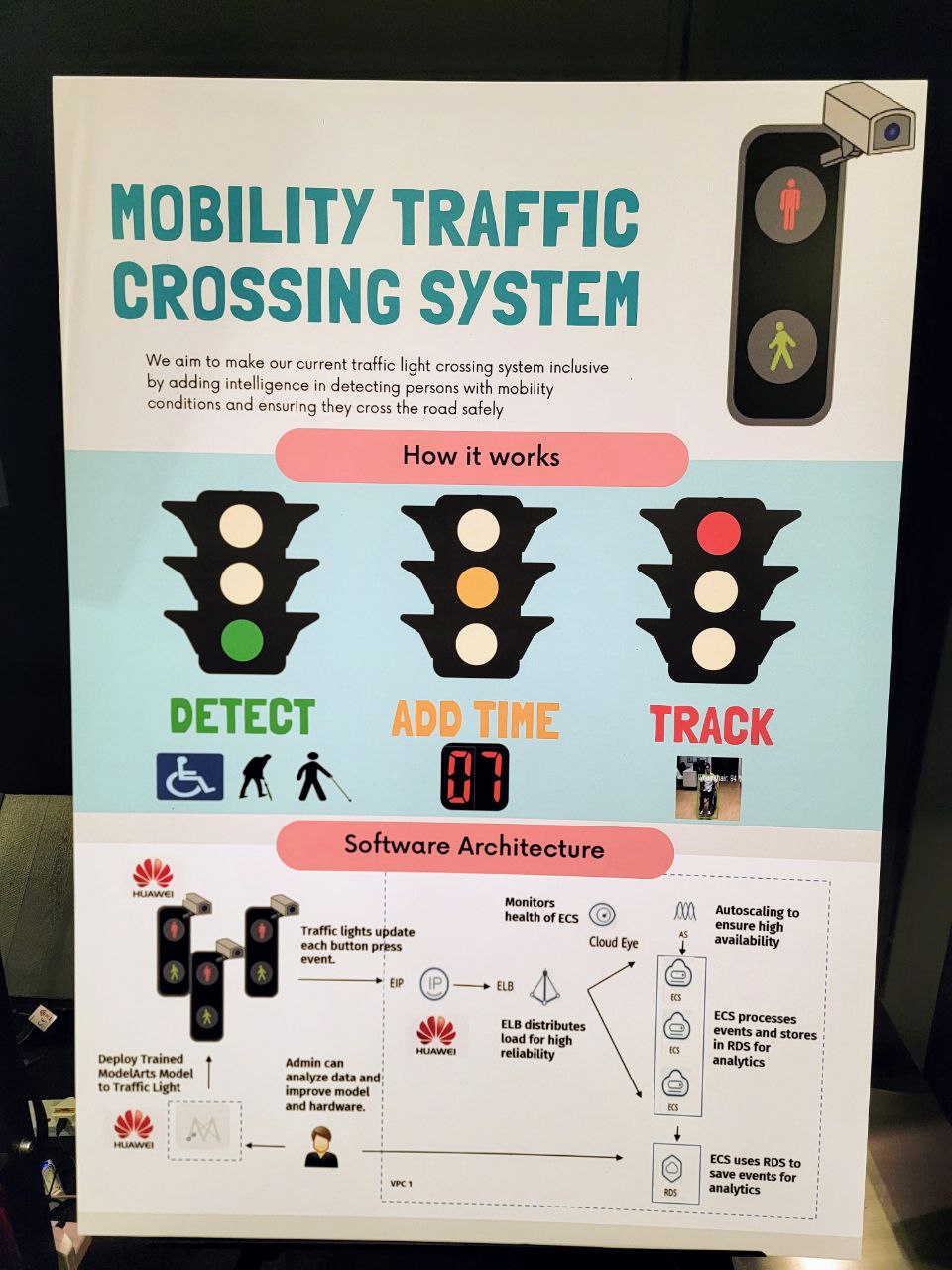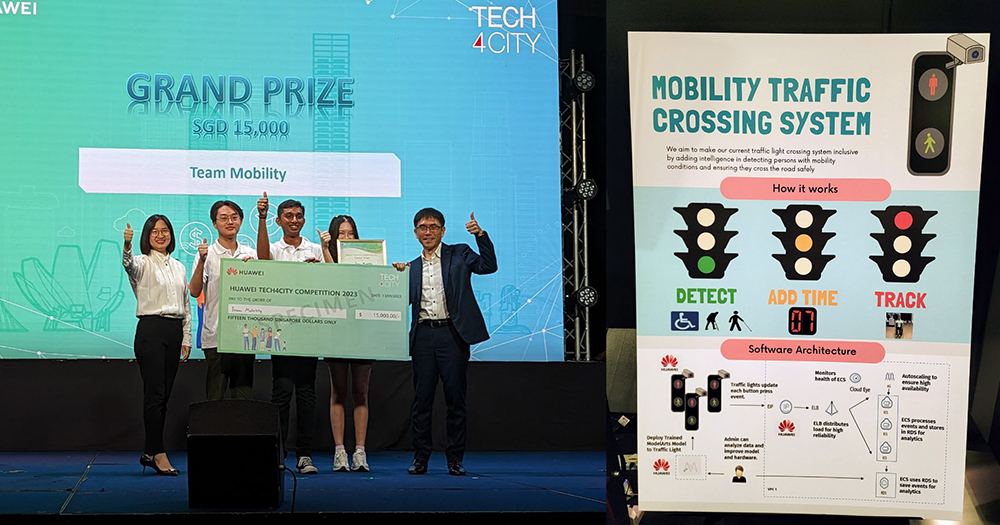Three students from the Institute of Technical Education’s (ITE) School of Electronics & Info-Comm Technology (SEIT) have clinched the top prize of S$15,000 at a competition organised by Huawei International called Tech4City.
Named Team Mobility, the students’ project involves enhancing Singapore’s traffic light system through an AI-powered system, such that the traffic lights extend the time needed for pedestrians to cross the road upon the detection of people using mobility aids in real-time.
Through extensive testing of the AI system, Team Mobility found their test set results showed great promise – wheelchairs from test images were detected with 83 per cent accuracy, while the average detection rate for walking aids was 84.9 per cent.
Apart from the grand prize money, the team also won an additional S$3,000 for the best innovation in mobility, sponsored by SBS Transit.
Winning team out of more than 140 teams
A total of eight shortlisted teams participated in the finals, which was themed on making Singapore a more inclusive, sustainable and liveable city for its inhabitants.
They were selected out of a total of 372 participants who formed 144 teams, with 89 proposals submitted to address the competition’s themes of well-being, learning, energy, mobility and finance.
In the shortlisting phase, proposals were assessed based on the depth of research, innovativeness and feasibility, social value, use of technology, and logical implementation of each idea.
The second prize, consisting of S$8,000, went to a team called Payment in the Dark, in which four students from the National University of Singapore (NUS) proposed including voice recognition features in payment-related apps to help the visually impaired individuals with cashless payment methods.
Meanwhile, the third prize of S$5,000 went to a team called Gnomes whose project aims to help Singaporeans consolidate their household energy usage in a one-stop platform and reduce their energy consumption.
Students were moved after seeing the difficulties experienced by those with mobility conditions in crossing the road
Speaking to Mothership, one of the students from the champion team, Praveen Nagatheran, said he had been “personally inspired” after witnessing people either on wheelchairs or with walking aids struggle to find their cards to tap on the green man plus reader, and also finish their crossing on time.
His teammate Zamien Ng echoed the same sentiment and observed that elderly people face the same struggle too.
Ng added that drivers in Singapore could be quite “colourful” with their language in such situations, when they have to wait for such people to cross the road.
The aim of their project is to therefore raise awareness among Singaporeans and encourage them to be more compassionate to such people.
Praveen added that the ball for the project got rolling once they pitched the idea to their teachers, who were also receptive to it.
How does the project actually work?
According to Ng, the project entails attaching a camera to a traffic light which prompts the traffic light to extend the timing of the green man upon detecting a person with mobility conditions.
The camera has been trained to capture three classes of objects: wheelchairs, walking aids and blind aids.
Real-time detection is done via the camera’s Huawei Cloud ModelArts AI development platform which utilises machine learning to improve its accuracy.
Ng said that a traffic light will not only be prompted to add extra time when it detects any of the aforementioned objects, but also turn on its audio function when it detects the presence of blind aids.
Extra time will also be added once again if it detects that the person with mobility conditions has yet finished crossing the road.
When asked by Mothership about why the extra time is not added immediately once the pedestrian crossing turns green, Ng replied that the consideration here was for traffic so that drivers did not have to wait too long.
 Photo by Matthias Ang
Photo by Matthias Ang
Looking into implementing the project at MRT stations and lifts
Praveen also noted that the proportion of Singapore’s elderly is growing.
The group is therefore looking at expanding the project to other areas such as MRT stations and lifts, Ng added.
Ng said that this could involve the installation of a CCTV which sends out an alert for assistance upon detecting a person with mobility conditions entering the MRT train.
Ng also suggested that with the same technology, a CCTV can also be used to detect a person with mobility conditions to hold the lift doors for them before they leave or enter the lift.
Praveen also said he is hoping that the group can execute a pilot test at MRT stations by the time he graduates in 2024, given that SBS Transit has already voiced its enthusiasm in implementing this project at some MRT control stations to enhance service efficiency despite limited manpower resources.
Why this team won
In reiterating just how much Team Mobility had impressed the judging panel, one of the judges, Calvin Chu – a managing partner at Eden Strategy Institute – noted that the team was “quite sensitive” to the broader ageing issue.
Chu commended the team for refusing to accept and challenging the current status quo.
The Green Man Plus programme has already been implemented at over 400 traffic lights around Singapore. Under this programme, senior citizens and pedestrians with disabilities can activate the Green Man Plus function by using their concession cards or dedicated cards and tapping it onto the reader, which is mounted on top of the button.
Furthermore, he noted that the team had demonstrated technical strength as it had worked on its information architecture, with multiple prototypes.
The team also has a ready customer for its product with SBS Transit’s keenness to roll out an iteration of the project at MRT stations.
The project is effectively something that the judges can see being implemented, he said.
This sponsored article made the author wish he picked up something AI-related while he was still studying.
Top photos by Matthias Ang
If you like what you read, follow us on Facebook, Instagram, Twitter and Telegram to get the latest updates.

